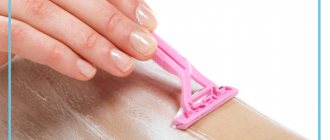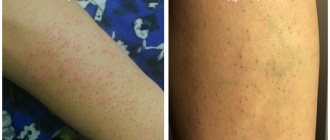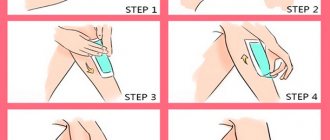The first laser hair removal procedure was performed in 1996. A ruby laser was used to remove unwanted hair growth. Soon it was replaced by more advanced technologies - alexandrite and diode lasers, the use of which makes it possible to solve the problem as physiologically as possible, without harm to health and with a guarantee of a positive result. However, questions about whether laser hair removal is harmful or not have still not lost their relevance. We will try to answer them by presenting expert information in an accessible form.
Types of laser hair removal
The type of laser hair removal depends on the type of lasers used for it. Today there are four of them.
- Ruby laser (used extremely rarely, as it is obsolete) with a wavelength of 694 nm, which destroys the hair pigment and does not have a detrimental effect on its follicle.
- Alexandrite laser (popular) with a wavelength of 755 nm, which effectively removes hair of any color growing on skin of phototypes I – IV.
- Diode laser (popular) with a wavelength of 808 - 810 nm, which is capable of removing dark and dark brown hair on skin of phototype I - VI.
- Neodymium laser (due to its “aggressive” effect is used in exceptional cases) with a wavelength of 1064 – 1320 nm, which affects the hair pigment and causes coagulation (sealing) of the vessels feeding its follicle.
Knowing the wavelength of light is necessary to estimate its absorption coefficient. Long-wave exposure easily reaches the follicle. On the one hand, this is good, but on the other, it means that its energy can be absorbed by competing skin chromophores (melanin and water contained in the tissue), which leads to a decrease in the effectiveness of hair removal. While short-wave radiation does not reach the follicle, it is poorly absorbed by skin chromophores, but it specifically affects the pigment of the hair shaft.
If we compare procedures on popular devices with each other, then hair removal with an alexandrite laser is considered more delicate. While the use of a diode laser allows you to treat darker skin of the face and body.
The benefits and harms of laser hair removal
The use of laser technology guarantees long-term results that can be successfully maintained throughout life.
Among the obvious advantages of the procedure, the following relevant points can be noted:
- non-invasive - without damaging the integrity of the skin;
- non-contact – only the laser beam affects the skin;
- painlessness - the use of cooling and local anesthesia eliminates discomfort;
- sterility – laser light energy demonstrates a bactericidal effect;
- versatility - the procedure is suitable for women and men with any skin type and hair color;
- high efficiency – all unwanted hair in the active growth stage is removed.
At the same time, directly opposite information about the uselessness and danger of procedures is actively discussed on popular forums and social networks. Its implementation is surrounded by myths reminiscent of “horror stories” about the dangers of laser hair removal for the body: they say it leads to the development of candidiasis (thrush), cancer and increased hair growth. It’s easy to refute these myths - it’s enough to have basic knowledge in the field of medicine and human physiology.
Laser light energy has a pronounced bactericidal effect. Its effect inactivates (destroys) pathogenic microorganisms, including fungi of the genus Candida, the active reproduction of which leads to the development of candidiasis.
Therefore, there are no negative consequences of laser hair removal in the bikini area. In this case, the exact opposite effect is observed: an absolutely clean field of “norm” - a complete absence of fungal infection, which is confirmed by the polymerase chain reaction method.
Laser light energy does not provoke uncontrolled proliferation (reproduction) of cells, characteristic of oncogenesis. Its exposure does not lead to the development of cancer! Moreover, recently lasers have been actively used in the treatment of cervical cancer, after chemotherapy and radiation therapy.
Laser light energy does not enhance hair growth. After all, this process is controlled by hormones that are produced in the endocrine glands of the body. During treatment of problem areas, the laser has no effect on them.
It is difficult to say on what basis such ridiculous myths are born, forcing girls to wonder whether laser hair removal is harmful to health. Answering this question, we can say with complete confidence that in the absence of contraindications and the procedure is carried out correctly, it does not cause any harm to the body.
Permanent laser hair removal in intimate places: types
There are several types of hair removal in and around the bikini area. They depend on the size of the area affected by the device.
Classic type of hair removal
This involves working with the hair roots along the edge of the underwear contour. That is, they heat the bulbs in a more visible area that is not covered by panties or swimming trunks. Hair is destroyed from the upper part of the pubis and inner thighs. This allows you to wear swimsuits and not think that you have to constantly remove something somewhere. This look is very traditional and acceptable by many women. For those men who, in principle, are not puzzled by the amount of hair on their entire body, this option is unattractive. But most often they prefer a different type of hair removal.
Laser hair removal for deep bikini
In this case, the hair removal procedure affects not only the swimsuit or underwear line, but also concerns getting rid of hair follicles on the entire pubic area and labia. This is a fairly intimate process that is trusted to qualified specialists. It involves being naked in front of a stranger. Most cosmetologists perceive such manipulation as something ordinary, but professionals will always treat your body with care, and your trust is no less important to them. On the Internet, by searching “” you can find videos that demonstrate the amazing effect of several sessions and the features of the procedure. Hair on the inside of the groin is also destroyed. All that remains is a neat vertical strip (the width, of course, is determined by the patient) on the pubis and in the perineum.
Complete hair removal in intimate areas
This is already mentioned about this type of procedure, you can find fans not only among women, but also among men. This type of manipulation includes complete hair removal in all intimate areas, including the skin between the buttocks. In this case, it is very important to find a cosmetologist to whom you are ready to demonstrate yourself without embarrassment, completely. Due to the intimate nature of the process, it is rarely filmed. So, total (meaning complete) hair removal occurs on the pubis, on the hips, and in the perineum or scrotum area, as well as in the gluteal folds and near the anus.
Contraindications for laser hair removal
Individual intolerance to laser radiation.
- Oncology.
- Insulin-dependent forms of diabetes mellitus.
- Herpes is in the acute stage.
- Epilepsy.
- Pregnancy, lactation period.
- Infectious, chronic diseases in the acute stage.
- Fresh tan.
- Multiple moles.
- Progressive benign skin neoplasms.
- Phlebeurysm.
- Wounds, damage, inflammation of the skin at the site of exposure, including tattoos.
- Predisposition to the formation of keloid scars.
- Systemic intake of medications that increase the photosensitivity of the skin.
- Chronic diseases, genital infections (in case of epilation of the bikini area).
Bikini area hair removal with laser for men
As we have already said, men also resort to such procedures. In their case, the process will take some time, and 8-10 procedures may be required, after which you can completely forget about the problem of excessive hair thickness in such a delicate area.
The procedure itself takes about 30 minutes, which was made possible thanks to the use of the most high-quality equipment, as well as the experience and competence of the cosmetologist.
The first stage is a consultation with a specialist, which all clients undergo regardless of gender. The specialist examines the bikini area, gives advice and recommendations regarding the upcoming procedure and finds out whether the client has contraindications for the procedure, which involves the use of a laser.
In addition, the cosmetologist’s tasks include telling how to prepare for the procedure and helping the client to relax, remove psychological barriers, clearly and clearly describing each stage of laser hair removal. In the vast majority of cases, at least 80% of men achieve one hundred percent results using this hair removal, completely removing excess hair in this area.
By the way, it is useful to know that hair located in the intimate area is in all cases more curly in shape than hair located on the head. This is explained by the fact that the hair follicles in this area have an oval shape, and in other places they have a circle shape.
Is it worth doing laser hair removal: indications for the procedure
Shaving, which has become traditional, is today considered not only outdated, but also a potentially dangerous method of hair removal. Using a safety razor at home causes microtrauma to the skin and can cause infection. It provokes ingrown hairs and the development of folliculitis (inflammation of hair follicles).
Often, irritation appears on the shaved area of skin in the form of small rashes and the effect of the so-called “blue beard” - when the subcutaneous part of the dark hair is visible, which does not look aesthetically pleasing. In addition, using a razor does not guarantee long-term smoothness - many women notice hair regrowth by the end of the first or second day after shaving. However, this is not a reason to use a laser.
Before you sign up for the procedure, you need to objectively weigh the pros and cons of laser hair removal. If we are talking about removing rare, unnoticeable hair that grows slowly and is not prone to ingrown hairs, then you can get rid of them using waxing or sugaring. Regular use of wax and sugar paste in a beauty salon or private office will help curb their unwanted growth without much difficulty.
When thinking about the need for laser hair removal, you should understand that to achieve a lasting result you will need to undergo a long course of procedures. Its duration is purely individual, after which it will be necessary to regularly carry out maintenance procedures and unquestioningly follow all the recommendations of the cosmetologist. Therefore, before deciding for yourself whether or not to undergo laser hair removal, you need to have time, money and be prepared for changes in your usual lifestyle.
Unwanted hair growth is not harmful to the body. Therefore, there are no direct indications for the use of laser. But analyzing the reviews of doctors about laser hair removal and the opinions of girls who have already completed the full course, it is still worth resorting to it.
Especially if you have the following list of problems:
- Large amount of unwanted hair.
- Dark, highly visible, coarse hair.
- Inconspicuous and light hair, as well as isolated gray hairs.
- Rapid hair regrowth after depilation.
- Irritation, redness, itching of the skin after using a razor, wax or sugar paste.
- Tendency of hair to ingrown.
- Folliculitis.
- Hairs on areas of the skin that are difficult to reach with razors, wax and paste.
- Bluebeard effect.
Laser hair removal easily solves these problems and guarantees long-term smoothness of the legs, armpits, bikini and other areas. A pleasant bonus is the improvement and improvement of skin quality at the site of exposure to laser light energy.
How long does laser facial hair removal last for women?
This question cannot be answered unambiguously. It all depends on individual characteristics.
Considering the structure of the hair, it is possible to get rid of facial hair for approximately 5 years. If there is a sharp contrast between the skin and the hair, growth may stop forever. To maintain the result, many cosmetologists recommend periodically repeating the procedure. In the presence of hormonal disorders, follicle activity may recover earlier than expected.
Possible consequences of laser hair removal
Let’s make a reservation right away: complications after laser hair removal occur in three cases:
- the cosmetologist and his client ignored contraindications;
- errors were made during laser processing - incorrectly selected light wavelength, energy density, pulse duration, lack of cooling, etc.;
- laser equipment of dubious quality was used.
When faced with these problems, negative consequences cannot be avoided. Most often, girls complain of complications such as:
- burns;
- age spots or, on the contrary, “burnout” of skin pigment;
- formation of scar tissue;
- allergic rashes;
- soreness and increased sensitivity of the skin in the treated area;
- hematomas;
- folliculitis;
- active growth of vellus hair;
- development of photophobia and vision problems;
- exacerbation of herpes, chronic diseases, etc.
Of course, without being an expert in the field of laser hair removal and having resorted to the procedure for the first time, it is impossible to assess the quality of the device, the competence and correctness of the cosmetologist’s actions. Therefore, along with the question of why laser hair removal is dangerous, you need to ask another, no less important question - is it dangerous to do it in this particular beauty salon or clinic.
To answer it, you need to study reviews about the organization and the doctors working in it. There is no need to ignore a preliminary consultation with them, because during casual communication you can assess the competence of a specialist: if he is not interested in contraindications, does not warn about side effects, does not give recommendations for caring for the treated area and promises “mountains of gold”, then you should not trust him "cosmetologist".
How often is hair removal done and is it possible to permanently remove hair with laser?
The statement that laser hair removal eliminates hair forever is often misunderstood. From a medical point of view, complete hair loss implies a temporary or permanent cessation of hair growth. Laser hair removal allows you to achieve complete, temporary hair loss with the possibility of partial, long-term reduction in their number.
This formulation sounds rather confusing and incomprehensible, but in fact it means that after using the laser, hair does not grow for a long time, and when its growth resumes, it becomes very sparse and inconspicuous. Understanding this point is extremely important when setting expectations for laser hair removal. Otherwise, disappointment from the procedure cannot be avoided.
As for the frequency of treatments, it is purely individual - adequate to the speed of hair regrowth. On average, to achieve a sustainable result of complete hair loss, problem areas are treated once every 4 to 6 weeks. After which maintenance procedures are carried out - once every 12 - 24 months.
Recommendations after the procedure
After the manipulations, the skin needs careful care. It is important to consider the following nuances:
- Avoid visiting the solarium and minimize exposure to the sun.
- Apply sunscreen before going outside. The SPF level should be at least 30.
- For the first 2-3 days after hair removal, avoid using decorative cosmetics.
- Choose skincare products only with gentle ingredients. They should be free of alcohol and acids.
- Apply anti-burn cream. It could be Panthenol.
- Avoid using aggressive sponges for washing your face.
- Do not visit the bathhouse, sauna or swimming pool.
The final result largely depends on the correct care after the procedure. It is important to follow the session schedule prescribed by the cosmetologist. If complications occur, consult a doctor immediately.
For a long-term effect without consequences, it is important to find a competent cosmetologist. Only modern and safe equipment is used. All cosmetologists have received higher medical education and take their work responsibly. During its operation, the salon received many reviews from grateful clients.
* — Information is valid at the time of publication of the article
Is epilation of armpits and bikini area harmful?
When answering the question whether a deep bikini is harmful or not, it is worth remembering the non-invasive, non-contact and sterile nature of the method.
Its implementation does not harm the external and internal genital organs of a woman. Confirmation of this is the active use of lasers for vulvovaginal rejuvenation, which eliminates age-related atrophy, muscle relaxation, stress urinary incontinence and prolapse (protrusion) of the genitals. Laser hair removal also does not cause any harm to the armpits. Author: Khazova Alla Sergeevna
Shallow, deep and extra deep bikinis for women
First, let’s find out what the nuances of laser hair removal of the intimate area are for women.
Three types of bikini hair removal degrees:
- deep;
- shallow;
- extra-deep;
In addition, there is a method for removing hair exclusively from the pubic area, the folds between the buttocks and the buttocks themselves.
If shallow hair removal is performed, the specialist removes vegetation, limiting himself to the contours of underwear. In the vast majority of cases, this is the optimal type of procedure, especially in cases where the client lacks self-confidence.
The essence of the extra bikini is that the laser works on the labia and the fold between the buttocks, but the most common choice of clients is the extra bikini, which includes all these areas, thereby achieving a complete absence of hair in the entire treated area.
What all of these options have in common is that all hairs that can be seen by the human eye are removed using a laser beam. Conventional hair removal of intimate areas, carried out using a laser, takes a short time (a specialist will need no more than thirty minutes), but a deep bikini will require a lot of effort and will take less than one hour. In order to avoid irritation in the mucous membrane, the specialist directs the laser to this area for a very short time.
The choice of most representatives of the fair sex falls on laser hair removal of the entire intimate area. However, everyone’s taste preferences and ideas about aesthetics differ, and some girls prefer to leave some pubic hair. Accordingly, in this case, you first need to shave your pubic hair in the way you want to see it immediately after the session. There are no restrictions here: by shaving you can give any shape to your hair.
How does light energy affect hair follicles?
The energy of a directed beam of light through dark hair reaches the follicle. Its cells heat up to temperatures above 70 degrees and die. The hair follicle dies. The effect of laser hair removal is lifelong, but on this particular hair !
In order to understand the problem, you need to know an important fact:
the hair that you see on your body is only 30-60% of all hair follicles that are provided by nature (in different parts of the body in different ways).
Where are the rest? - a curious reader will ask?
Some of the bulbs are simply “sleeping”; the body has not needed them yet. They wake up, for example, in the event of a hormonal “explosion”. And some of the hair is in the catagen and telogen stages: these are the stages of hair life when they do not grow, the hair follicle is renewed inside the skin.
Any hair removal, be it electro-photo or laser, “kills” only active, growing hair (in the anagen stage) . In response to this, the body launches recovery processes, dormant follicles wake up, and “telogen” follicles enter the anagen stage.
The more active the hormonal background (in other words, the younger the patient), the more intense the processes of hair regrowth take place, but this is no longer the same hair that was!
The process is absolutely identical for both photoepilation and electrolysis! Therefore, the principle of these three methods of hair removal is the same, as is the effectiveness of these methods.
If the laser device is set up correctly and the cosmetologist works efficiently without missing treatment zones, then the hair is destroyed forever!
Recommendations for preparation for the procedure and rehabilitation
During the two weeks preceding hair removal, it is not recommended to sunbathe. Before the session, remove hair using a razor so that at the time of the procedure the hair length is no more than 2-3 mm.
After hair removal, it is better to avoid sun exposure of the treated area for 2-3 weeks. If the skin is red, it would be a good idea to use an emollient cream (to relieve inflammation). To remove hair between laser hair removal sessions, it is better to use a razor or a special cream. Electric epilator, tweezers, wax are not the most suitable options. Such hair removal may negatively affect the effectiveness of the upcoming procedure.
What are the benefits of laser hair removal in the bikini area?
As you already understand, the procedure has a preparatory stage and some restrictions that occur after the session itself. However, there are many more advantages:
- The procedure itself is short in time, since the laser does not treat each follicle individually, but the entire area as a whole.
- Visible effect after the first visit to a cosmetologist.
- Hairs do not grow into the skin and no scars form; the procedure is safe.
- Painless procedure. This is an extremely important point if hair removal takes place in such a sensitive area.











